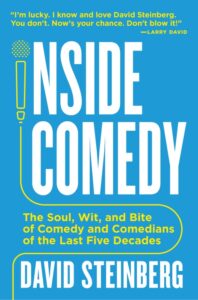Inside Comedy by Canadian author and comedian David Steinberg is described as a look behind the curtain of the comedy scene of the last 50 years, and although promising in concept, the book proves itself to be convoluted and disappointing in execution.
The semi-autobiographical story is filled with accounts from Steinberg’s career, abstract life musings, and details about the world of comedy from a performer’s point of view. With non-fiction, readers must be prepared for the mental processing that comes with the genre. That said, there’s a large amount of willpower needed to sift through the contents of this book. There are no clear expectations set for readers before they begin, which exacerbates the problem of clarity. Is this a book about Steinberg’s career? Is it a commentary on the genre of standup comedy? A love letter to comic artists? This work appears to be a mix of all of the above, which makes the summary inaccurate and the book annoying to keep up with.
Inside Comedy is trying to be multiple things at once, and that doesn’t play in its favour.
In addition to problems with clarity, Steinberg also seems to have a problem with name-dropping celebrities. Although it’s impressive to have worked with so many talented artists in the world of comedy, Steinberg fails to make it clear how the experiences aided him in a way that makes mentioning the celebrities relevant. It feels as if the book is more about the people he’s worked with than it is about the author’s experiences.
To his credit, Steinberg does seem very appreciative of his colleagues, but this doesn’t negate the fact that his usage of names like Will Ferrell, Ellen DeGeneres, Jim Carrey, and Jimmy Fallon distract from the narrative that he is working to craft.
There are, however, some redeeming qualities in this book despite the general confusion and number of celebrity mentions, particularly the interesting historical context nestled within the pages of this story. Born in 1942, Steinberg is able to provide fascinating insight into different political movements that took place during his career, such as the 1977 human rights campaign. Telling history through unconventional avenues such as comedy makes the story fresh and captivating. It creates a new lens for the audience to view old information, and in this sense Inside Comedy is successful. It is, however, disappointing that the book only really succeeds in a way that it did not intend to in the first place.
Despite having an interesting concept, the book’s execution proves to be confusing and lacklustre, and with such a long career in the world of comedy, it’s a shame that the most interesting pieces of the story are hidden gems.

